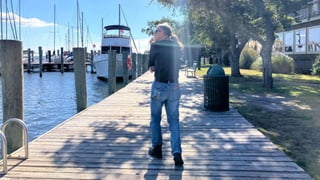SLIDES: 45 Years of Inhabiting the Sacred in Manteo, NC: Insiders and Outsiders Reflect, Debate and Predict
Presented at EDRA56 in Halifax, Nova Scotia, Canada, on May 30, 2025, by Amber Nelson. See the presentation on YouTube: https://youtu.be/3uWl56ycSmo & the paper: https://www.slideshare.net/slideshow/paper-45-years-of-inhabiting-the-sacred-in-manteo-nc-insiders-and-outsiders-reflect-debate-and-predict/279976544 Manteo, NC’s 1980 participatory plan is championed as the poster child of grassroots community design and regarded as a focus of place attachment research, and inspiration to designers internationally. This paper discusses what has succeeded and failed in the plan, now 45 years old, in the perception of both locals and outside experts, and where the city should consider going in its next 45 years. Manteo’s goal was to recover itself from 22% unemployment, yet when plans were presented, the community responded with, “You are destroying our town.” This outright rejection of traditional planning approaches led to a participatory design breakthrough of mapping the people’s most deeply valued patterns of everyday life. With this “Sacred Structure” uncovered and legalized in design regulations, Manteo’s citizens were able to create a place not of high style design, but rather one of place attachment. We ventured to analyze the Sacred Structure’s longevity and reasons for its success. As “academic outsiders,” we questioned the sacredness of the city as enjoyed by locals and as it’s been showcased internationally. Additionally, we were curious what, if anything, is threatening the Sacred Structure both today and into the future. Our research method includes interviews with city insiders including civic leaders and Randy Hester, the designer of the 1980 plan as well as academic outsiders intimately familiar with Hester’s work on Manteo yet not directly involved in the project. The study culminated in 2024 with an on-site symposium which included comparisons to other sacred place research in Japan and in the book, Inhabiting the Sacred in Everyday Life. Our findings indicate all acknowledge the “specialness” of the sacred-place-inspired design, but there is disagreement about newcomers contributing to or posing threat to the vitality of the existing Sacred Structure. Additionally, only locals are able to speak to the decades of political struggles and value tradeoffs, whereas outsiders are able to most-readily articulate lingering racial segregation and the greater impact of the plan on the island as well as internationally. The Sacred Structure is intact yet evolving, as any vibrant city evolves. However, there are concrete successes and failures we extrapolate and use as cautionary tales for approaching the upcoming city plan. Due to shifting demographics and climate change there are additional challenges, so we predict how the Sacred Structure (88% intact, expanded or relocated as of today) and near full employment will fare against future uncertainties such as population trends and rising tides.




































More Related Content
Recently uploaded (20)
SLIDES: 45 Years of Inhabiting the Sacred in Manteo, NC: Insiders and Outsiders Reflect, Debate and Predict
- 1. 45 Years of Inhabiting the Sacred in Manteo, NC: Insiders and Outsiders Reflect, Debate and Predict Amber D. Nelson Nao Kusumoto 楠本奈生, Kanon Koba 木塲佳, Masato Dohi 土肥真人 Randy Hester, and Angel Khoury
- 3. 1980 Plan for Manteo, NC
- 10. 1980 Manteo’s Sacred Structure
- 11. 400th anniversary of the first English colony in the New World
- 12. Creef Davis Maritime Museum
- 16. Roanoke Island Festival Park
- 17. 1980 Manteo Sacred Structure and 2024 Manteo Sacred Structure
- 18. 400th anniversary of the first English colony in the New World.
- 20. Elizabeth II Replica Ship
- 21. Jumping off the bridge as a right of passage, despite the polluted water
- 24. Pineapple
- 31. Orange Dots = Latino Households
- 34. Camp 4 Yosemite National Park: fighting to preserve sacred space
- 35. Study of the resilience of sacred places in Ookayama, Tokyo, Japan a: Station Square b: Shopping Streets c: Senzokuike Park d: Tokyo Institute of Technology e: Places with a view of Mt.Fuji f: Places related to water systems g: Elementary & Junior high school h: Neighborhood park i: Grave j: Temple, Shrine and small shrine k: Community dining l: Flower garden
- 36. Manteo ca. 1980 Manteo today
